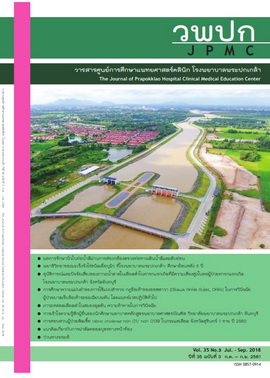Accuracy of Ottawa Ankle Rules (OARs) for diagnosis of acute ankle injury by general physicians
Main Article Content
Abstract
Abstract
Background: Ankle injury is one of the most common orthopedic injuries presented at Emergency Departments. The majority of these patients frequently undergo plain radiographs, even though there is no sign or symptom of fracture.
Objective: To evaluate the accuracy of Ottawa Ankle Rules (OARs) in acute ankle injury diagnosed by general practitioners (GPs)
Materials and methods: Data collection was performed at Bangchak hospital from December, 1st 2017 to February, 28th 2018. Eighty-one patients who had ankle injuries were recruited. This prospective and descriptive study divided six GPs into 2 groups to examine the patients. Group 1 GPs received extra-training for OARs. Group 2 GPs who had no OARs training was controlled group. All patients were later sent for plain radiographs. Two groups were compared and analyzed using Chi square test and Diagnostic test evaluation.
Results: The results suggested that OARs-trained group produced higher diagnostic accuracy compare to non-OARs-trained group. Diagnosis using OARs yielded the following parameters: accuracy 92%, sensitivity 92%, specificity 92%, Positive Predictive Value 85% and Negative Predictive Value 96%.
Conclusion: Ottawa Ankle Rules-trained physician could improve diagnostic accuracy, and reduce the number of unnecessary plain radiographs in patient with acute ankle injury.
Keywords: acute ankle injury; physical examination; radiography; Ottawa Ankle Rules
Article Details
References
patients with acute ankle injuries: role of the physical examination. AJR Am J Roentgenol
1991; 157:789–91.
2. Stiell IG, Greenberg GH, McKnight RD, Nair RC, McDowell I, Worthington JR. A study to
develop clinical decision rules for the use of radiography in acute ankle injuries. Ann
Emerg Med 1992; 21:384–90.
3. Stiell IG, McKnight RD, Greenberg GH, McDowell I, Nair RC, Wells GA, et al. Implementation
of the Ottawa ankle rules. JAMA 1994;271:827-32.
4. StiellI, Wells G, Laupacis A, Brison R, Verbeek R, Vandemheen K, et al. Multicentre trial to
introduce the Ottawa ankle rules for use of radiography in acute ankle injuries. BMJ 1995;
311:594-7.
5. McBride KL. Validation of the Ottawa ankle rules: experience at a community hospital. Can
Fam Physician 1997; 43: 459-65.
6. Bachmann LM, Kolb E, Kolher MT, Steurer J, ter Riet G. Accuracy of Ottawa ankle rules to
exclude fractures of the ankle and mid-foot: systemic review. BMJ 2003;326(7386):417-23.
7. Pijnenburg AC, Glas AS, De Roos MA, Bogaard K, Lijmer JG, Bossuyt PM, et al. Radiography
in acute ankle injuries: the Ottawa ankle rules versus local diagnostic decision rules. Ann
Emerg Med 2002; 39: 599-604.
8. Kelly AM, Richards D, Kerr L, Grant J, O'Donovan P, Basire K, et al. Failed validation of a
clinical decision rule for the use of radiography in acute ankle injury. NZ Med J 1994;
107:294–5.
9. Burns N , Grove SK. The practice of nursing research: conduct, critique&utilization. 5thed.
St Louis: Elsvier Saunders; 2005.
10. Polit DF, Beck CT. Essentials of nursing research: appraising evidence for nursing practice.
7thed. Philadelphia: Wolters Klower; 2004.
11. Cohen J. Statistical power analysis for the behavioral sciences. 2nd ed. New york :
Lawrence Relbaum Associates; 1998.

